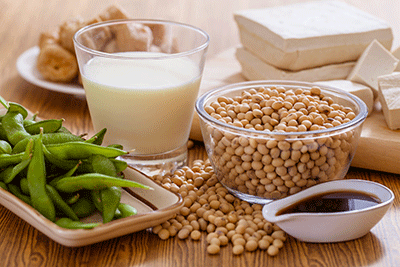I include tofu and tempeh in my diet. Is soy good for my health, and can its estrogen-like properties help or harm me?
Your Question: I include tofu and tempeh in my diet. Is soy good for my health, and can its estrogen-like properties help or harm me?
Our Response: The benefits of dietary soy products have been debated for over 5,000 years. Our current understanding of the composition and metabolism of soy is now well defined. Its role in health, however, is more controversial.
Soy products contain phytochemicals, plant-derived bioactive non-nutrients called isoflavones, that contain a phenol ring that binds to estrogen receptors. Thus, the debate has been whether soy can mimic the positive or negative effects of estrogen.
Soy beans, the major source of dietary soy, contain two major inactive isoflavones—genistin and daidzin. When genistin is activated to genistein by bacteria in our intestines, it becomes s(-) and r(+) equol, the most studied metabolite of soy.
Many animal studies, and fewer human studies, have identified health benefits from the isoflavones of soy. The most discussed are a reduction in the components of the metabolic syndrome, including decreases in type 2 diabetes mellitus, cardiovascular disease, and blood pressure, and improvements in LDL cholesterol. Other estrogen-like improvements attributed to soy include protection from osteoporosis, better weight maintenance, increased activity, better control of stress, and reduced hot flashes. Since it contains no lactose, soy is good for those who are lactose intolerant.
So why the controversy? Data from animal studies do not necessarily correlate with those of humans. For example, in rodents, daidzein-derived equol represents 70% to 90% of all isoflavones. Yet, only 30% of Western women have the intestinal bacteria needed to metabolize daidzein to equol as compared with 60% of Asian women. And even within a single-study species, different methodologies, durations of observation, and dosing regimens make study comparisons difficult.
Soy products also differ if measured by content of isoflavone mg/100 gm food: Soy flour (172.55), tempeh (60.61), green raw edamame soy beans (48.95), tofu (18.04), soy milk (10.73), and soy sauce (1.18).
Finally, the role of soy as protector or stimulant for breast cancer remains controversial. Despite many analyses, it appears that soy’s estrogen-like properties show little preventative value for and little risk of breast cancer.
Making soy part of one’s diet appears to have overarching benefits for health, and its isoflavone component, to date, has no apparent risks.
James Woods | 1/16/2020




